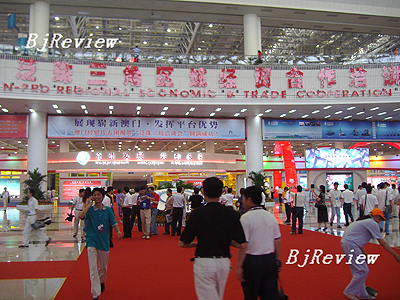
The Pearl River in south China flows from the west to the east, eventually joining the South China Sea. The Pearl River drainage area includes Guangdong, Fujian, Jiangxi, Hunan, Guizhou and Yunnan provinces, the Guangxi Zhuang Autonomous Region, as well as the two special administrative regions of Hong Kong and Macao. In 2004, it launched a cooperative economic development project with Sichuan and Hainan provinces that keep close ties with the Pearl River drainage area, called pan-Pearl River Delta regional cooperation. This area makes up one fifth of China's total landmass, tantamount to the aggregate area of France, Germany, Britain, Spain and Poland. Its population accounts for one third of the national total. In 2006, the GDP of the nine provinces (autonomous region), excluding Hong Kong and Macao, reached 6.63 trillion yuan (nearly $870 billion), accounting for 31.7 percent of the country's total. After three years of development, the pan-Pearl River Delta region has become an important cog in the Chinese economic development machine.
On June 10, a cooperative program signing ceremony was held at the Hunan International Convention & Exhibition Center. Governors of the 11 provinces (autonomous region) and special administrative regions joined hands, initiating a new development era for the pan-Pearl River Delta region.
Zhou Qiang, Governor of Hunan Province and host of the high-level forum on pan-Pearl River Delta region economic cooperation, explained that all contractual sides had conducted initial research and formed a consensus in terms of industry transference, market match-making, and labor and financial cooperation. The agreement states that all members of this cooperative program should further open their markets, overcome protectionism, eliminate local policies that hold back market integration and fair competition, strive to eliminate obstacles restricting regional circulation, and achieve regional economic integration and the free flow of capital, industry, technology and human resources in the region, so as to gradually form an open, orderly and fair regional market.
Connecting the dots
During the course of its economic development, China has witnessed the mushroom growth of economic development regions, such as the Bohai Sea Rim Region, the Yangtze River Delta Economic Area and the old industrial base in northeast China. The pan-Pearl River Delta cooperation is one in a long line.
In many regional economic development projects, administrative power is ubiquitous. Provinces and municipalities involved tend to act on their own, and such mentality brings more competition rather than cooperation, resulting in redundant construction. However, the pan-Pearl River Delta region hopes to avoid these traps by achieving integrated regional economic development, according to the Pan-Pearl River Delta Regional Economic Cooperation Framework Agreement signed in June 2004.
"The strategic goal of regional economic cooperation is to abolish administrative restrictions on economic development, make full use of market mechanisms in resources distribution and achieve free flow of products and production factors in the region, in order to form an orderly, rational and mature regional industrial structure and distribution base," said Huang Huahua, Governor of Guangdong Province.
Connected by a convenient transportation network, the 11 provinces and administrative regions are negotiating how to establish a reasonable regional work distribution system.
"For instance, Guangdong is a major base for the manufacturing industry, and Hong Kong an international financial, trade and shipping hub," said Huang.
Currently, this region has already achieved integration in product distribution. For instance, the products of Guizhou to be sold in Guangdong must meet the quality standards set by the Guangdong quality supervisory department, otherwise they would not qualify for the market. In the late 1980s, these standards underpinned the protectionism derived from administrative divisions. Last year, quality supervisory departments from the nine mainland provinces (autonomous region) agreed to acknowledge each other's local standards, so as to break through market divisions.
"This regional economy marks three phases in its strategic development," said Huang Huahua. "The first phase features economic cooperation, the second institutional integration and the opening of the production factors market, and the third industry reshuffling and integration. Now, we are heading for the third phase," added Huang.
Building bridges
Lu Bing, Chairman of the Guangxi Zhuang Autonomous Region, said the ultimate goal is to turn the pan-Pearl River Delta region into an integrated economic region with international competitiveness.
|
